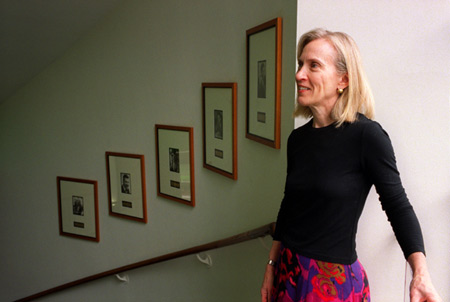A new comfort zone? Fewer women keeping names on marriage
Trend may show maturation of women’s gains

The research, by Henry Lee Professor of Economics Claudia Goldin and by former Harvard undergraduate Maria Shim ’01, highlights a trend that is a bit perplexing to the study’s authors because the societal trends that in previous decades led to women keeping their names – delayed marriage, increased education levels, greater numbers and achievement in the workforce – remain.
“There’s been no change in the underlying factors, therefore, we have a puzzle,” Goldin said.
Ironically, Goldin said she believes it was the gains that women made over the past few decades that may have led to the recent decline. Where once a woman keeping her own name after marriage was a way to make a statement of equality for women, that is less important today, when many women enjoy equal access to education, jobs, and relief from the traditional strictures that kept them in the home, Goldin said.
The research, drawn from an examination of The New York Times marriage announcements, Massachusetts birth records, and Harvard alumni records, grew from Shim’s senior thesis, which she completed in 2001. The article was published in a recent issue of the Journal of Economic Perspectives.
The article highlights the proportion of women declining to take their husband’s name in marriage over the last three decades. It tracks growth from a very low level – between 2 percent and 4 percent in 1975, through a sharp rise in the 1970s and 1980s before its decline in the 1990s to just below 20 percent in 2000.
Goldin attributes the initial increase to the societal revolution concerning women’s status that began in the 1960s. She highlights several defining indicators that show a correlation between the number of women keeping their own name and the age of first marriage. For college graduate women born in 1950, the average age of first marriage was 23. For those born just seven years later, it had risen to 25.5. That trend has continued, until today the average age of first marriage among college graduate women is about 27, Goldin said.
Another indicator is educational attainment, as the numbers of women who attend college and professional or graduate schools also rose along with the tendency of women to keep their own names. Together, Goldin said, these factors provide women with a greater opportunity to “make a name” for themselves in the workforce. The longer period of independence after they leave home and before they get married allows women to create an identity that they may be reluctant to give up.
But something happened in the 1990s, Goldin said. Massachusetts birth records, which list the full names of both the baby’s mother and father, provide a broad look at what’s going on in society, Goldin said. Those records show that 23 percent of college-educated women kept their own name in 1990, but 17 percent did in 2000.
Similarly, Harvard alumni surveys for the classes of 1980 and 1990 showed that, 10 years after graduation, 44 percent of 1980 graduates who had married kept their own name, while just 32 percent of 1990 graduates kept theirs.
The New York Times data is contradictory, Goldin said, indicating a continued trend to roughly 33 percent of brides keeping their names today.
Goldin dismissed the data from the Times, however, as changes in the way the Times selected which announcements to run may have altered results, making the data less representative of broader society. With the more comprehensive survey represented by the Massachusetts birth records, Goldin said she’s confident the decline uncovered by the birth data and the Harvard alumni records is the true trend.
But how accurate a trend, she isn’t sure. Because Massachusetts is apparently unique among states in the data provided by birth records, the study cannot be repeated for the entire nation, Goldin said.
“My sense is that the trends will be the same [elsewhere], though the levels may be off,” Goldin said.
Though the study highlights a shift in decisions by today’s brides, Goldin said it cannot explain that trend. Her own sense, Goldin said, is that the trend reflects a maturing of the gains won by the women’s movement. Women getting married in the 1990s were teenagers in the late 1980s and grew up in an America where they faced dramatically different choices from their mothers and grandmothers.
“Their mother may have worked and been college-educated. There was probably a degree of equality in the household, where the mother passed on to the daughter, ‘be good in school’ and ‘you’re as good as anyone,’” Goldin said. “Where their mothers were told [when they were young] that if you do better than the boys, they won’t like you.”
Where prior generations felt a need to keep their own names as a way to make a statement, Goldin said, that need isn’t felt as urgently by today’s young women, who may be looking for ways to bind their new families together, as sharing a last name can.
“There’s an inner urge to bond – and [there are] crazy glues that bond people together. Sharing a name is one of them,” Goldin said.




